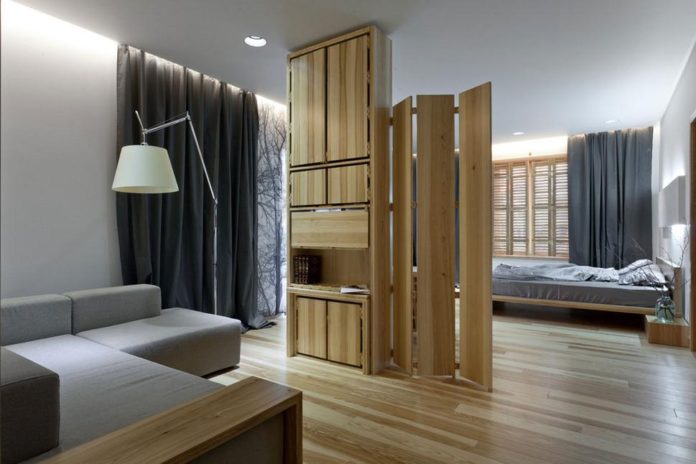It’s not an uncommon practice, especially in urban apartment rentals, for tenants to add temporary walls to their living spaces. A temporary wall is most often used to “split” one bedroom into two smaller bedrooms, but there are many other potential uses for a temporary wall as well.
If you’re interested in adding a temporary wall in your living space, you may be wondering whether this is a project you can take on yourself. Depending on your level of skill with carpentry and the availability of tools/supplies, you may be able to build your own wall. In other cases, it may make more sense to hire a professional.
Benefits of Temporary Walls
There are many advantages to adding a temporary wall to your living space. If you’re like most people living in a big city, you’re a renter. This means you cannot make permanent structural changes to your living space. A temporary wall allows you the freedom to change up the layout of your apartment without making permanent structural changes in the process. In most cases, a temporary wall can be easily dismantled without damage when you move out.
If you have roommates, adding a temporary wall can provide you and others with more privacy. For example, you could add a temporary wall between your shared bathroom shower and the sink/vanity, which would allow one person to shower privately while another person uses the remainder of the bathroom to get ready.
In some cases, a temporary wall could even add an extra bedroom to your living space. This can be done by sectioning off a part of the existing common area or even dividing a large bedroom into two smaller ones. The end result here is that more people are able to comfortably live inside the apartment and have their own space. And when you consider high rental prices in big city markets, the ability to create your own two-bedroom apartment with the rent of a one-bedroom can save you (and your roommates) a lot of money.
Before You Build…
Excited to add a temporary wall to your rental? Before you do, there are a couple of things you need to prioritize.
Check Your Lease Agreement
Start by checking your rental agreement to see if there are any rules against adding temporary walls to your dwelling. You may need to get explicit permission from your landlord or property manager to add even temporary walls; if this is the case, be sure to get that permission in writing.
The last thing you want is to violate the terms of your lease by adding a wall that is not permitted, which could result in the termination of your lease or inability to recoup your security deposit.
Decide on What You Need
As you explore possibilities for adding a temporary wall in your apartment, you’ll need to make some decisions regarding not only the placement of the wall, but other components as well. For example, if your temporary wall will be used to create an additional bedroom, then you’ll probably need to factor in space for a separate door/entrance.
What about creating a multi-purpose wall? Some temporary walls can be built with shelving so that you can enjoy added storage space in addition to creating a separate room in your rental. Take some time to consider just how extravagant you want to get with your wall design before moving forward.
Temporary Wall Options
When it comes to adding a temporary wall to your existing living space, you can either build the wall yourself or hire a professional for help.
Build One Yourself
This option is only recommended if you have some experience with carpentry and working with power tools. This method is also best if you’re only looking to add a wall and don’t need additional accessories, such as doors or shelving. It’s also important, again, that you get written permission from your landlord before completing this project because it does involve some drilling into joists.
To build your own wall, you’ll need:
- a power drill and circular saw
- a stud finder
- wood screws
- two-by-fours and corkboard sheets
- a tape measure
Begin by measuring the distance from the floor of your apartment to the ceiling; this will tell you how long you’ll need your two-by-fours to be cut. Subtract a couple of inches from this measurement to account for the horizontal support you will install on the ceiling. You can cut these yourself or have them cut to size at your local home improvement store for added convenience.
Next, cut and drill the horizontal supports into the ceiling; these are where you will drill your vertical two-by-fours into place using wood screws every two feet. When installing horizontal supports, make sure you’re drilling into the joists and not directly into the ceiling drywall.
Once the framing of the wall is complete, drill individual pieces of corkboard into the studs to complete your wall. You can use drywall if you’d prefer, but this will be more costly and difficult to remove. You can spruce up the appearance of a corkboard wall by hanging stylish wallpaper, artwork, or even using inexpensive contact paper to create a unique design.
Hire a Professional
If you’re not so comfortable with the idea of building your own wall, consider hiring a professional to do the work for you. There are a number of temporary wall installation companies that will not only build a temporary wall for you but remove it free-of-charge when your lease is up. These companies can often accommodate special requests, such as adding windows, doors, and even soundproofing as needed.
Some companies even offer temporary wall solutions that can be installed without nails or screws, which may be easier to get your landlord on-board with. These are known as non-pressurized walls and typically don’t run entirely from the floor to the ceiling, but can still be effective at separating space for an additional bedroom or another purpose.
Enjoying Your Refreshed Space
Adding a temporary wall to your apartment or office can be a great way to enhance privacy and even increase the potential to bring in more roommates (and cut down on your share of rent!). Just be sure to always get permission from your landlord or property manager before moving forward with a wall project.













